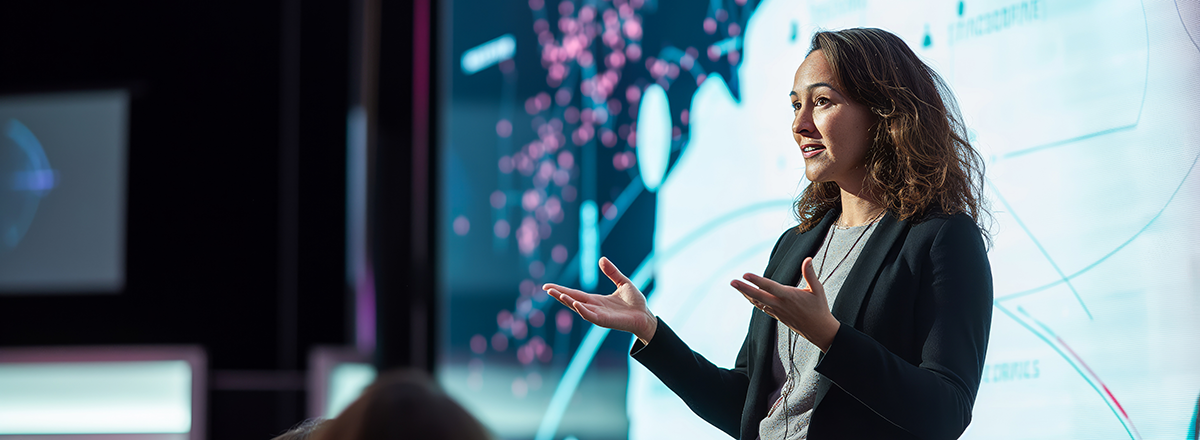
A Keynote is Not a Slide Deck, It’s a Stage for Strategy
Rebecca Michelle TittertonThere’s a big difference between making slides look good and crafting a keynote that feels cinematic. A great keynote isn’t just a set of slides. It’s a shared, live experience. The speaker becomes more than just a messenger; they become a storyteller.
What you have to say is important and exciting, and your visuals should reflect that energy. It’s where visuals and voice come together to build emotion and energy, leaving your audience not just informed, but moved.
Not all presentations are keynotes, but let’s be clear, all presentations matter. A great sales deck can win a deal. A thoughtful internal report can align a team. A clear client update can build long-term trust. These moments are essential to how organizations communicate. They simply serve a different purpose. Presentations explain. Keynotes move.
A keynote, however, plays a unique role. It’s not just about explaining—it’s about igniting. Whether you’re speaking to 500 people or 5,000, the expectation is different. A keynote is theater. It’s storytelling at scale. Crafting the narrative often involves combining elements like future vision, business strategy, product roadmaps, brand identity, cultural values, and even customer success stories. It’s one of the few moments where all of that must be crafted into a single, cohesive narrative.
Every transition should have purpose. Every pause should land with intent. Every visual should reinforce, not compete with, what you’re saying. This level of intention is critical because keynotes are often a brand or leader’s most public, high-investment communication moment of the year. They’re watched by global audiences and designed to shape perception, build excitement, launch visions, and drive action. When done right, a keynote doesn’t just deliver a message—it drives momentum.
Emotion is the Engine
Let’s talk about emotion. Information and impressive animations alone don’t inspire action. Feelings do.
If you want your message to last beyond the moment, you need to design for feeling, not just function. That’s the real power of a keynote. It creates an emotional connection that makes the message unforgettable. The best keynotes build tension and resolution, much like a good story. They draw you in, shift your perspective, and leave you with something to carry out of the room.
Yet, this arc isn't an accident. It’s carefully crafted through pacing, tone, visual rhythm, and even silence. I saw this firsthand while supporting speakers at Apple’s WWDC, where every moment is designed for impact. It’s not just about launching a feature—it’s about creating anticipation, trust, and belief in what comes next. They don’t just explain the “what,” they make you believe in the “why.”
Designing for Connection
There’s a chicken-and-egg tension with keynote creation: do you design for the speaker, or the other way around? The real answer is neither. You start with the audience.
Connection comes from empathy. From designing with the audience’s emotional journey in mind. What do they need to feel in the first two minutes to care? What should they walk away thinking differently? What belief should shift, or what action should feel suddenly urgent? These are the questions that drive the structure—not just what fits on a slide.
By answering three fundamental questions before you even begin designing your presentation, you’ll set the foundation for a keynote that speaks directly to your audience.
Who am I speaking to?
Understanding your audience is the first and most crucial step in creating a successful keynote. When you know who you’re speaking to, you can tailor your message in ways that resonate deeply with their challenges, fears, goals or ambitions.
Why are they here?
Knowing their motivations is just as important as knowing who they are. Are they there to be inspired, informed, or to gain a deeper understanding of something new? The answer will help you decide how to frame and deliver your presentation to directly address their needs.
What are they expecting?
This is key. If your audience is there to hear about innovative technology or fresh business strategies, don’t just repackage what they already know or expect. Deliver your content in a way that challenges their thinking and adds value, keeping them engaged and giving them a reason to care.
When a keynote works, audiences are engaged, eyes are up, and you can hear the pause after a powerful moment. People remember the message, not because it was packed with content, but because it was designed to resonate.
A successful keynote isn’t just one that looks good, but one that engages. It turns passive viewers into active participants. That’s the difference between a good presentation and a great keynote: it’s not just about communication—it’s about connection.

Rebecca Michelle Titterton
Rebecca Michelle is a Senior Designer at Studio Science, specializing in presentation design and visual storytelling. She believes that impactful design isn't just about aesthetics; it's about creating an emotional connection that turns complex ideas into memorable experiences. With a passion for Keynote and an eye for impactful visuals, Becca has created tailored design solutions for clients ranging from startups to Fortune 500 companies like Apple, Duarte, Land Rover, Microsoft, and Smartsheet.